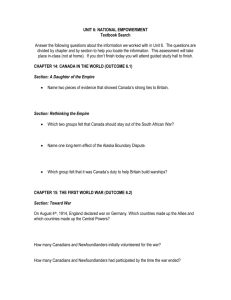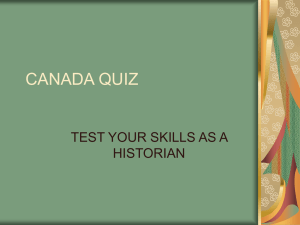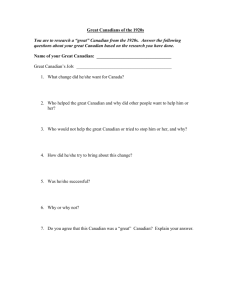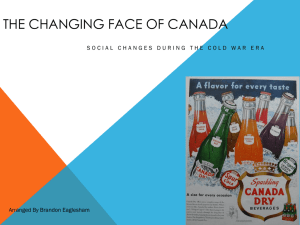Social Studies 11 Counterpoints Chapter1 Test
advertisement
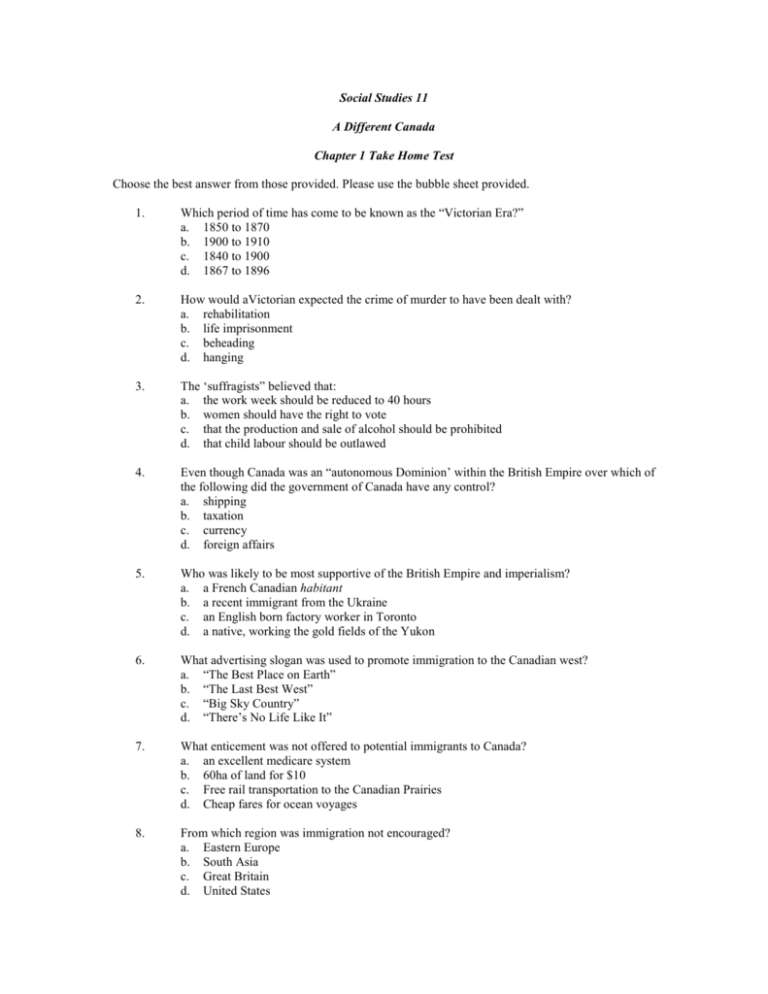
Social Studies 11 A Different Canada Chapter 1 Take Home Test Choose the best answer from those provided. Please use the bubble sheet provided. 1. Which period of time has come to be known as the “Victorian Era?” a. 1850 to 1870 b. 1900 to 1910 c. 1840 to 1900 d. 1867 to 1896 2. How would aVictorian expected the crime of murder to have been dealt with? a. rehabilitation b. life imprisonment c. beheading d. hanging 3. The ‘suffragists” believed that: a. the work week should be reduced to 40 hours b. women should have the right to vote c. that the production and sale of alcohol should be prohibited d. that child labour should be outlawed 4. Even though Canada was an “autonomous Dominion’ within the British Empire over which of the following did the government of Canada have any control? a. shipping b. taxation c. currency d. foreign affairs 5. Who was likely to be most supportive of the British Empire and imperialism? a. a French Canadian habitant b. a recent immigrant from the Ukraine c. an English born factory worker in Toronto d. a native, working the gold fields of the Yukon 6. What advertising slogan was used to promote immigration to the Canadian west? a. “The Best Place on Earth” b. “The Last Best West” c. “Big Sky Country” d. “There’s No Life Like It” 7. What enticement was not offered to potential immigrants to Canada? a. an excellent medicare system b. 60ha of land for $10 c. Free rail transportation to the Canadian Prairies d. Cheap fares for ocean voyages 8. From which region was immigration not encouraged? a. Eastern Europe b. South Asia c. Great Britain d. United States 9. In which year was the Chinese Exclusion Act made into law? a. 1881 b. 1896 c. 1911 d. 1923 10. Opposition to immigration from India was best exemplified by: a. the “St. Louis Incident” b. the “Empress of India Incident” c. the “Komagata Maru Incident” d. the “S.S. Beaver Incident” 11. Which of the following was not designed to destroy “aboriginal culture?” a. the sale of alcohol b. the reservation system c. residential schools d. the outlawing of traditional native ceremonies 12. In what year did anti-Asiatic riots break out in Vancouver? a. 1896 b. 1900 c. 1907 d. 1914 13. Which was not common in “working class” areas of Canadian cities? a. adequate sanitation b. overcrowding c. tuberculosis d. short life expectancy 14. Prior to 1900, most Canadians lived: a. in cities b. in small towns c. on farms d. in tribal groups 15. Which process encouraged the movement of most Canadians to the cities? a. electrification b. modernization c. transmogrification d. industrialization 16. Which of the following major companies did not develop in Canada at the “turn of the century”? a. Imperial Oil b. CanWest Global c. Dominion Steel d. Massey-Harris 17. In response to the growing economic power of huge companies what organizations did working class people begin to form? a. fraternal orders b. Masonic Lodges c. Benevolent associations d. Trade unions 18. Which of the following did not assist in helping to increase productivity in the fishing industry? a. gasoline engines b. refrigerated railcars c. the “Iron Chink” d. sonar 19. Which environmental disaster seriously depleted the fish stocks on the West Coast? a. El Nino b. The Prince George chlorine spill c. The “Hell’s Gate” rock slide d. The “Exxon Valdez” 20. _________________________ was the first man to transmit radio signals over long distances. a. Sam McLaughlin b. Reginald Fessenden c. George Herman Ruth d. Guglielmo Marconi 21. ___________________ products such as Canada Dry, Shredded Wheat, Palmolive soap and Heinz ketchup became common place on the shelves of Canadian grocery stores. a. consumer b. producer c. pasteurized d. freeze-dried 22. The largest colonial empire in the world was run by __________________ in 1910 a. the Spanish b. the Americans c. the Germans d. the British 23. Which term is used to describe citizens of French-Canadian heritage? a. Canadians b. Canadiens c. Bois Brule d. Metis 24. The Alaska Boundary Dispute was settled in favour of _________________________ . a. the Spanish b. the Americans c. the Russians d. the British 25. The name given to supporters of the British Empire was ____________________ . a. nationalists b. democrats c. imperialists d. communists 26. ______________________ became the first French-Canadian Prime Minister of Canada in 1896. a. Louis St. Laurent b. Jean Chretien c. Sir Marcel Dionne d. Sir Wilfrid Laurier 27. Which of the following was the author of Anne of Green Gables? a. W.P. Kinsella b. Margaret Atwood c. Lucy Maud Montgomery d. Judy Rebick 28. In 1905, what is now the province of Quebec was made up of Quebec and the: a. District of Mackenzie b. District of Keewatin c. District of Assiniboia d. District of Ungava 29. The RMS Titanic sank off the coast of Newfoundland in: a. 1910 b. 1911 c. 1912 d. 1913 30. Which Canadian provinces did not exist in 1903? 1. British Columbia 2. Alberta 3. Saskatchewan 4. Newfoundland a. 1 b. 1 and 2 c. 2 and 3 d 2, 3 and 4



